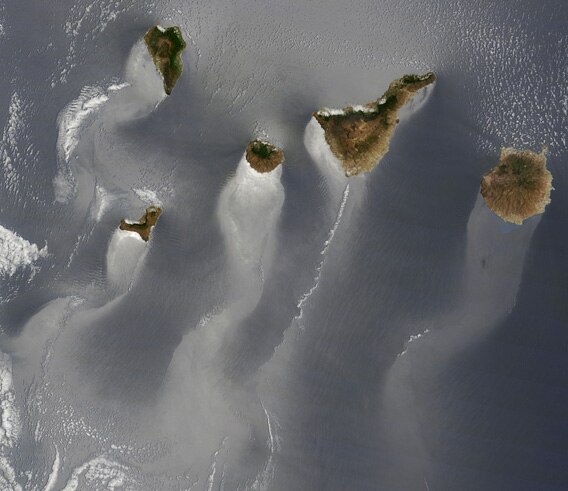Create a free profile to get unlimited access to exclusive videos, sweepstakes, and more!
When a Canary Wakes

I know I post lots of pictures of erupting volcanoes seen from space, but this oneâs a little different. There are no eruptions, but you can see five volcanoes:
Those are five of the 13 islands making up the Canaries, an archipelago of volcanic islands off the coast of Morocco. In the picture, taken by NASAâs Terra Earth-observing satellite, you can see the islands leaving wakes in the water, most likely from wind blowing past and around the volcanoes. As the water ripples, sunlight reflects off itâcalled a glintâgiving the water a silvery look. This can sometimes make for incredibly lovely and striking scenes when photographed from space.
The wiggles in the wakes may be due to water and wind interacting, but I wonder if weâre seeing nascent von Kármán vortices, where wind flowing past an obstacle creates whorls and swirls downstream. Thatâs a different effect than whatâs going on with Tenerife, the largest islands; most likely changes in the air flow past the volcanic peak are whatâs creating that long, tight helical pattern flowing downwind. Itâs pretty amazing.
Although I find all these effects fascinating and quite pleasant to look at, Iâm also posting this picture as a bit of self-indulgence. Back in 1998 I attended a meeting on brown dwarfs (objects more massive than planets but less so than stars) on the island of La Palma, the shark-tooth shaped one in the upper left. The entire northern part of the island is dominated by the caldera of the volcano Taburiente, and during the meeting we all took a half-day to visit it. The magnificence of it cannot be overstated; it towers 2,400 meters (8,000 feet) above the sea, and you drive through several different ecosystems on the way up.
The best part is a vast rift in the western side, an enormous funneling wedge cut out of the flank where the caldera collapsed and several cubic kilometers of rock slid into the Atlantic. This happened something like 500,000 to 750,000 years ago, and the slice out of the mountain remains. Seeing that was life-altering; such an obvious catastrophic event written so plainly in the rock had a profound effect on me, and cemented my love of geology. Standing on the caldera rim surrounded by a pumice field that stretched off in every direction didnât hurt, either.
There are well over a thousand visible volcanoes on our planet and not enough time to visit them all. Iâve seen a few, either from a distance or having stood upon them, but in this lifetime there will opportunities for more. I donât know how many Iâll get to see, but I know it wonât be enough.


























